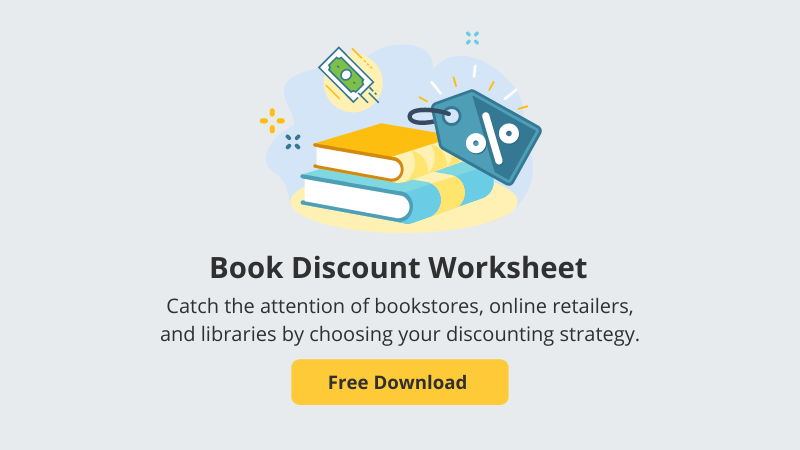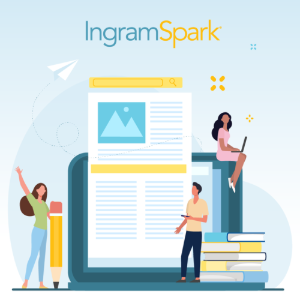After you've spent the time and money to edit, design, and market your book, the thought of selling it at a discounted price may seem counterintuitive. However, offering a discount is an excellent way to expand your reach in the book distribution channels. Discounting your book can help get it picked up by retailers. Here's how.
Before determining how much to discount your book, you need to consider your ideal sales channels. Will you make it available online, in physical stores, or both? Do you plan to make it available in libraries, chain stores, indie bookstores, or all of the above? Your discount will depend on how and where you want your book to be available. IngramSpark allows you flexibility in setting your discount at the time of title setup, but you still need to understand how book discounts work.
What is a Wholesale Discount?
Your wholesale discount determines how much a wholesaler will pay for your book. When they sell your book to a retailer, bookstore, or library, they pass on a portion of the discount to them, depending on your wholesale discount. Retailers and bookstores will sell your book at the list price or may offer it at a discounted price. This is how the wholesaler, distributor, retailer, and bookstore earn money to operate their businesses and hopefully make a small profit.
Many authors think that the only way to get their book into bookstores is through the traditional publishing path—this is hardly the case. Many bookstores are more than happy to support local authors. All you have to do is ask. However, most bookstores will not be willing to buy your book directly from you. It's more likely that they'll want it to come from a wholesale distributor, such as Ingram Book Group, LLC., from which they order all of their other books. Selling your book with a wholesale discount and making it returnable via a book distributor is a good way to get it on bookstore shelves.
It might seem counterintuitive to discount your book, but consider what you are getting in return. IngramSpark's wholesale distribution network allows you to reach more than 45,000 retailers and libraries. When you take advantage of this established distribution network, those retailers and libraries become part of your sales force. They can give your book the kind of exposure that would be impossible to achieve alone. You'll do better selling 2,000 books at a discount through major distribution channels than you would selling 200 at list price on your own.
Taking on the Competition
1. Traditional publishers: Traditional publishing houses like Penguin Random House offer a discount to wholesalers. The wholesaler will pass a portion of that discount to retailers, bookstores, and libraries. Retailers and bookstores will sell the book at the list price, so they can make a profit when they sell the book to readers. In order to compete for shelf space, you must also offer a wholesale discount. If you don't want your title rejected by retailers, set your book up with a competitive wholesale discount (e.g., 50-55%) and, if possible, offer returns. Returns can be very costly, and publishers need to be financially prepared for the return of any books sold through IngramSpark's wholesale service offering.
2. Other self-publishers: Not all self-publishers understand why they should offer wholesale discounts. The savvy indie author, like you, is already beating out tens of thousands of other self-publishers just by knowing the necessity of offering these discounts. This knowledge puts you on a similar playing field as major traditional publishers.
A wholesale discount lends credibility and professionalism as you market your book to retailers. Because having this discount makes you competitive with traditional publishing houses, retailers will see that you know what you're doing and will be more likely to do business with you.
What Wholesale Discount Should I Offer Bookstores?
The trade discount most publishers choose to offer booksellers is 55%. IngramSpark provides the option of setting a discount within the range of 40% (minimum) to 55% (maximum). Applying a discount less than 55% can possibly limit the sale of your title to booksellers; however, this may be the right choice for you depending on your author goals and marketing strategies.
Let's walk through an example: If your book is 6x9, black-and-white, 150-page, paperback book is priced at $15 and you set a 55% wholesale discount, the wholesale price of the book will be $6.75.
$15 list price - ($15 X 55% discount) = $6.75 wholesale price
The wholesale price is the amount the wholesaler will pay IngramSpark for the book. A wholesaler will keep a portion of that discount and pass along the rest to the bookstores ordering the book, and retailers may pass along a discount to the end consumer (for example, the retailer may sell your $15 book for $12.99 in their store). The cost to print your book (based on format choices you've made such as hardcover or paperback, black-and-white or premium color, page count, etc.) and a market access fee will be deducted from the $6.75 wholesale price. You will be paid what is left over as your publisher earnings on that sale.
Use IngramSpark's Publisher Compensation Calculator to see what you'll earn per book sale with your wholesale discount factored in.
You may be thinking, "Hey, why would I set a wholesale discount that enables the bookstore to make more money than me on the sale?" but consider how many sales you might not achieve without the help of retailers. If you have your own e-commerce and fulfillment methods and an unlimited fan base that you know will purchase from you without fail, then offering a higher wholesale discount may not be necessary. However, in order to participate in the IngramSpark wholesale distribution offering, the minimum wholesale discount you can offer is 40% in the United States and 35% in the United Kingdom, European Union, and Australia. Most likely, more potential readers will visit their local bookstore or online retailer than will visit your author website or hand you cash for a copy. You have to consider what that exposure is worth to you.
You promote your book and let people know from which retailers they can purchase it. The retailers handle your book's inventory, ordering, and selling, so that you can earn compensation on your $15.00 book, but it may be money you wouldn't have earned otherwise. And if your book sells through stores, the stores may place more orders, and multiple sales could equal more than the handful of $15.00 sales you may get if you try to do it all on your own.
If you think you'll offer a bookstore a 40% wholesale discount so that you get more and they get less, consider how many books they're asked to stock and how limited their shelf space is. Offering a wholesale discount lower than 55% will cause a retailer or bookstore to receive a “short” discount instead of their standard trade discount, and is not typically a big enough incentive for them to purchase your book as stock for their shelves.
How Does the Discount Work on Books Ordered by the Publisher?
When you (the publisher) order your book through your IngramSpark account, no discount is involved. With these publisher-direct orders, you pay for printing and shipping. For example, if you're hosting a book signing, you might order 50 copies of your book to have on hand for the event and sell the book to attendees at list price. Your profit is the difference between the price you paid for printing and shipping, and the price individuals pay for your book at the signing. Using our paperback example from above, it would cost $169 to print 50 copies (plus shipping to wherever you're located). If you sold all 50 copies at your $15 list price, that would be $750 revenue minus $169 to print (plus shipping), and what's left over is your profit. Or perhaps you know a school teacher whose class will read your book—you can order books for the students yourself at the publisher-direct price and invoice the teacher according to your agreed-upon price.
Do Libraries Need a High Discount?
Libraries are different altogether because they're not trying to sell your book. They have a set budget for purchasing books, so you don't have to offer them a high discount. You do want to make sure your title metadata properly catalogs your book for libraries; otherwise, they'll have difficulty finding it to make their purchase.












